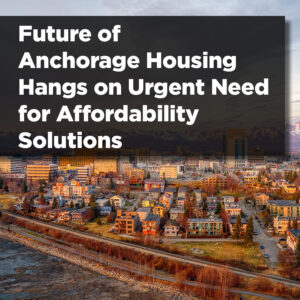
By Connie Yoshimura
Anchorage housing continues its first-class trajectory resulting in more and more buyers shut out of the market. According to MLS statistics, the first five months of 2024 showed an 11.95% increase in closed volume but only a 4.01% increase in sold units. The average sales price increased 7.54 percent to $499,636. Of the 225 single-family homes available for sale last week, 130 were above $500,000.
Anchorage is losing its families to the Valley where the average sales price was $436,933. The Valley is where you can still buy an acre of land for $84,000 plus the cost of a well and septic for a total value of $100,000. If the cost of land should be 25% of the value of a new home then the Valley is right on the money. But tell me where in Anchorage you can do the same?
The Mat-Su Borough, the Anchorage Municipality, and the Kenai Borough are competing for the buyers of family homes. And their difference is not just the price of land but most importantly the cost of home ownership. A $500,000 Anchorage home has a property tax of $850 per month. In Mat-Su, the tax is $460 per month. And in the Kenai Borough, it’s $430. A $400 difference in tax requires a homebuyer to make somewhere between an additional $1,200 to $1,600 per month in order to qualify for the mortgage which is one reason why the Mat Su had over 50% of all the single-family home starts in Alaska in 2022.3
I’ve previously stated that Anchorage is for the well-to-do. Forty homes valued at over a million dollars have been sold so far in Anchorage this year. Some mortgage lenders are now offering special loan programs for the medical community to physicians, pharmacists, orthodontists, et cetera, up to $1.5 million with no mortgage insurance required and zero down which has helped fuel those sales. There are also some new construction loans up to $2.0 million and even loan amounts up to $3,000,000. And yes, you’ve read all that correctly. Check with your local mortgage lenders who have the capability of keeping these loans in their portfolio for qualified buyers. Anchorage needs our medical professionals but we also need the scrub nurses and lab techs, who work three 12s and live in the Valley.
Countering that high-end financial opportunity is the Alaska Housing Finance Corporation which hopes to adopt a 3% downpayment program and there is talk of a $25,000 stipend for first-time home buyers. The first rung on the housing ladder is where the help is most needed. After all, housing is the backbone and the foundation for any community. Without housing we don’t have schools; trails for walkers; and customers for fast food or tablecloth restaurants. There is no housing affordability without government assistance either at the local, state, or federal level which had its origin for returning veterans after WWII. I doubt interest rates will ever decrease to pandemic rates. Perhaps, a small dip before the national election but in today’s politically turbulent world, a buyer would be wise not to wait. I doubt the cost of homeowners insurance will decrease due to our multiple natural disasters and our sheetrock, lighting fixtures, and appliance imports from China will not cost any less. But let’s not just complain. What, if any are there any solutions? We can’t control mortgage rates or homeowners insurance but we can, locally, give property tax breaks to at least first-time home buyers. We can find a way to support offsite infrastructure for roads, water, and sewer. Developers/builders can and should be responsible for infrastructure costs within a tract to create lots but we shouldn’t have to pay for asphalting fifty-year alleys, residential road extensions, and oversized water/sewer pipes from 300 feet away.
We now all recognize that Title 21, adopted in 2013, was a disastrous overreach that required, as an example, fake windows above a garage just to make in someone’s judgment a more attractive façade. The overwhelming majority of home buyers want to live in a detached single-family. Nationally, that single family is getting smaller reducing from 2,516 in 2021 to 2,343 square feet in 2023. That downsizing trend is not just for our aging boomers. We can all do with a little less square footage. Keep in mind construction costs are based on square footage, whether it’s footings, framers, sheet rockers, or the size of the primary bath suite with a spa tub and a rain shower. Still, the overwhelming majority of home buyers want to live in a detached single-family home. But that ‘want’ may not be reality. A baby’s first step on the housing ladder just may be an attached townhome in a PUD, a condo with its exterior entrance, or a zero lot line on a fee simple lot but with CCR’s to project its value from a neighbor painting their unit a bright yellow. If done right, low-density multi-family may be the only way Anchorage can survive its housing crisis.

 Connie Yoshimura is the Owner and Broker of Berkshire Hathaway HomeServices Alaska Realty. With over 40 years of residential real estate experience, she continues to be a leader in Alaska’s housing market. Most recently, she sold the highest-priced home ever recorded in the Alaska MLS.
Connie Yoshimura is the Owner and Broker of Berkshire Hathaway HomeServices Alaska Realty. With over 40 years of residential real estate experience, she continues to be a leader in Alaska’s housing market. Most recently, she sold the highest-priced home ever recorded in the Alaska MLS.
Leave a Reply